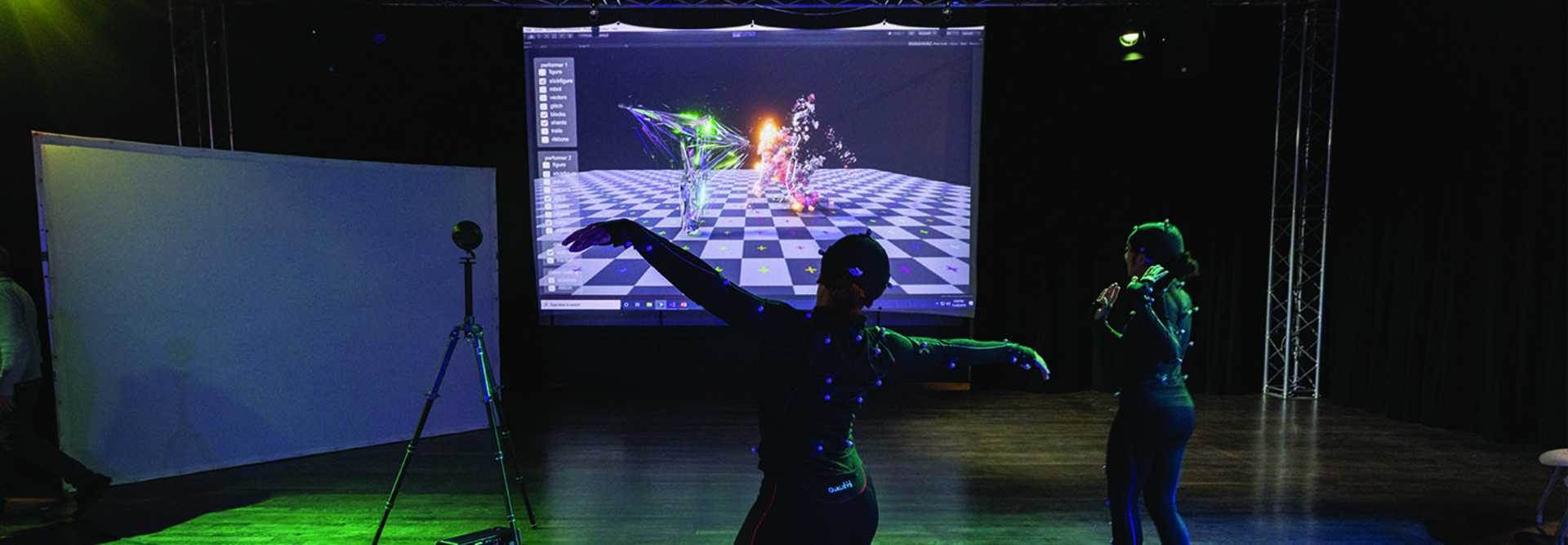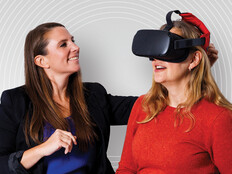Finding content for virtual reality labs can pose a challenge for universities and colleges because the technology is evolving so quickly. To give students the desired immersive learning experiences, professors and instructional designers often must create their own content.
Institutions such as the University of the Arts in Philadelphia, Pa., are helping change that. UArts is paving the way for research and exploration in immersive media technologies with the Center for Immersive Media, a 5,600-square-foot research center that opened last November. The facility is equipped with the latest technology, ranging from video projectors to motion capture systems, which allows people to engage in and learn about virtual and mixed reality, human-computer interaction, and more.
UArts enlisted Alan Price, who previously served as the acting director of The Ohio State University’s Advanced Computing Center for the Arts and Design, as CIM’s founding director. Price, who has more than 20 years of experience working in the field of real-time computer graphics systems, motion capture and immersive displays, was instrumental in the facility’s design.
EdTech spoke with Price about his goals for the center, its design and the future of immersive media technology in higher education.
EDTECH: What prompted UArts to invest in the Center for Immersive Media?
PRICE: It came out of the desire to incorporate more new and emerging technologies into all disciplines at UArts. The concept was initiated by university President David Yager, and a committee of faculty and staff was formed to develop a strategy for what a center of this kind would be like.
UArts also established a new mission statement, which is on the advancement of human creativity, and I think that’s right in line with the contemporary technologies and topics that are in our domain today.
CIM’s mission is really to connect, engage and be a catalyst for creativity with faculty, students and the professional community. Research and development are integral to that — not only through the adoption of new technologies but the anticipation aspect of it as well.
EDTECH: How was the facility designed, and what does it offer?
PRICE: We worked with AV specialists, lighting designers and architects to create a space that’s highly versatile and accessible not only to students but to faculty and staff and others in the professional community. We wanted the design to be forward-looking, to have the high capacity for the kind of technology we installed and will be installing. Right now, we have tools like optical motion capture systems, video projectors, lighting equipment and a 360-degree camera. We also have multiple virtual reality head-mounted display systems, like Vive Pro and Oculus Rift S.
We wanted to have individual spaces for the development of immersive media projects and installations, as well as a classroom. We were also interested in offering courses that are relevant across multiple disciplines here. Right now, we have three: Projection, Body and Storytelling; Art Making in VR; and Spatial Audio Composition. They’re all full — we capped them at 15 students each. To accommodate that, we have a 16-station computing classroom with PCs optimized for real-time computer graphics rendering. We also have two project rooms that are multifunctional. They have ceiling grids that allow for the creation of projection installations, virtual reality environments and responsive spaces.
At the facility, we’re also going to offer workshops for faculty to come and gets hands-on experience working with the systems we have. Their interest in doing that is to then take that knowledge back to their classes and have students working with some of those systems. We’ve also been talking with people in the professional community and other universities, as well as doing some grant writing toward some projects. But there isn’t anything in production right now; it’s just way too early. I am excited for what’s on the horizon.
EDTECH: Did you come across any challenges in introducing these immersive media technologies?
PRICE: One challenge we’re dealing with is with VR headsets. They’re still really designed for the single consumer. Trying to adopt them in an academic environment, where you have multiple users logging in to one computer or sharing a user account to use them, can be difficult. But the potential with these headsets and this technology overall is so powerful that now is the time to really figure out what we can be doing with them in an academic environment and in creative research.
EDTECH: How can exploring immersive media technologies benefit students?
PRICE: When we see new technologies come out, we ask a lot of questions: What can you do with that? When is it appropriate to use? How do you take advantage of the powerful aspects of that particular technology? Answering those questions and making calculated decisions based on them is valuable because that’s how you make new things happen. And I think someone coming out of our program who is able to do that can really play an important role in a wide number of industries, from the arts to the sciences.
Immersive media also opens up a new way of spatial thinking. People have different ways of observing the world and problem-solving — take three-dimensional problem-solving, which students are becoming more adept at today. With these new technologies, students can develop new ways of interacting and thinking and leverage those in the workplace.
EDTECH: What do you see in the future for immersive media technology in higher education?
PRICE: If we think back to when computers were first being introduced to classrooms, what typically happened was there would be a computer lab set up and run almost as if it was separate from all of the other disciplines. I think where we are with immersive media — specifically virtual and augmented reality — is that there’s a trend of incorporating these technologies into a center or facility where people might go to learn about them.
That’s what we’re doing with CIM. It’s a place where you can continue to explore new possibilities of working with these tools that go beyond conventional or mainstream ways. From there, I think they’ll start to move into classrooms where students from all disciplines can begin using them, and they’ll start to become a more ubiquitous tool.














